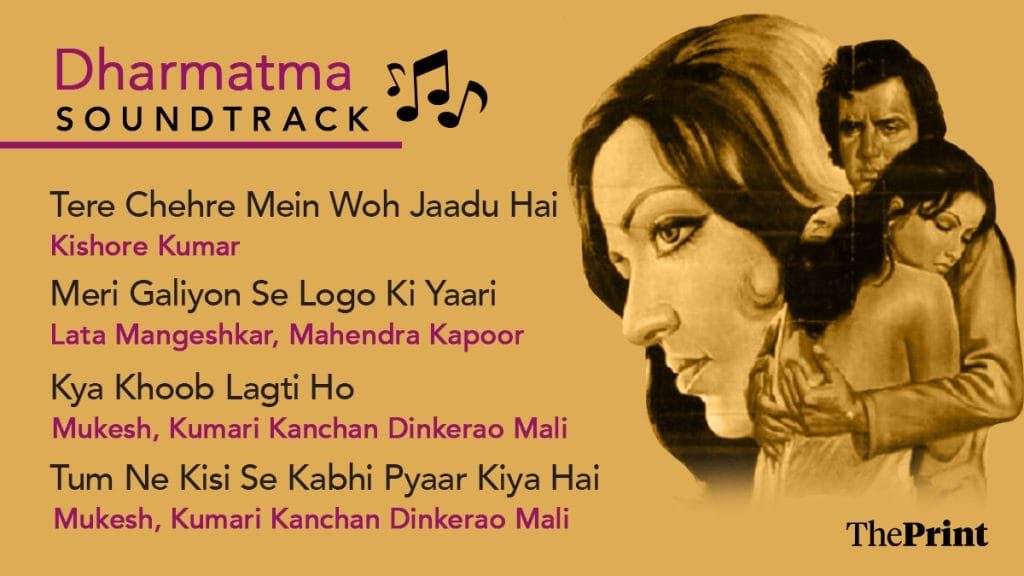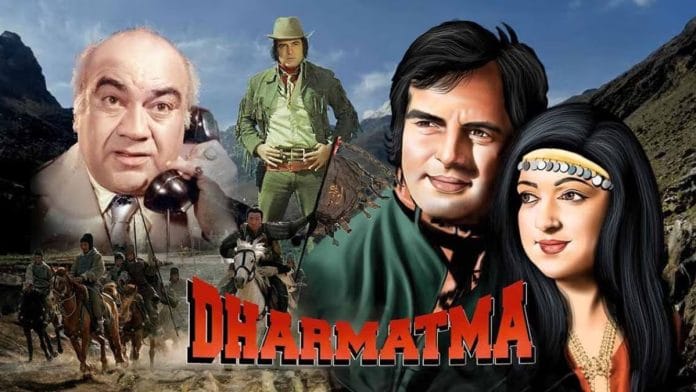In the era of ‘Angry Young Man’ and dacoit films, actor Feroze Khan made his own mark. The flamboyant star spared no expense in showcasing a glamorous and multi-cultural world. In 1975, Khan directed and starred in Dharmatma, the first Hindi movie to be shot in Afghanistan. Released in the same year as Ramesh Sippy’s Sholay and Yash Chopra’s Deewar, the movie was a blockbuster. Its plot, music and ensemble cast made sure it stood out; made on a budget of Rs 1.25 crores, its lifetime collection is Rs 5 crores.
Khan took the story of Francis Ford Coppola’s The Godfather (1972) and made it his own by basing it on the gambling kingpin Ratan Khatri. The film begins with Seth Dharamdas (Prem Nath), a Matka or betting king and philanthropist who helps the poor and needy. Khan, who plays his son, Ranbir, doesn’t even appear on screen until almost 30 minutes into the film. His opening scene is a heated argument with his father.
Dressed in a black suit, Ranbir does not hesitate to call out his father’s illegal empire, “Chori chahe ek rupaye ka ho ya ek lakh ki, chori chori hoti hai (Whether it’s a rupee or a lakh, theft is ultimately theft),” says Ranbir. He also calls out Prem Nath on his hypocrisy. “Aap samajhte hai ki matke ke zariya lakhon karoron ghar tabah karke chand gareebon ke muh mein roti dal di toh aap dharmatma ban gaye (You have destroyed crores of families with your gambling business; feeding a few poor and calling yourself a saviour does not compensate for that),” he thunders.
Dharamdas’ enemies lay an elaborate plot to kill him and take over his business. His son-in-law Kundan (Imtiaz Khan), married to his daughter Mona (Farida Jalal), is also part of the plan. The movie truly begins when Dharamdas is killed, and Ranbir returns as the avenging son.
Also read: ‘Love Story’ launched Kumar Gaurav as teen heartthrob of 1980s India. He was a nepo baby
Sartorial edge
Khan went on to direct Qurbani (1982), Janbaaz (1986) and Dayavan (1987). Horses were a predominant feature in Khan’s films, and Dharmatma was no different. He meets his romantic interest, Reshma (Hema Malini), while riding a horse in the forest. The horse-based sport of Buzakshi and ram fights, part of the cultural lives of Nomadic tribes of Central Asia, were also shown in the film. The film has stunning shots of the rocks and ruins of Afghanistan and the deserts. Through the character of Reshma, who is part of the nomadic community, the audience gets a glimpse of their lives.
While other films in the decade often focused on a male character who embodies rebellion, frustration, and a strong sense of justice against societal ills and corruption, Khan’s films created a world that was no less than what James Bond films brought to Hollywood. It was not the world of the middle class or the working class.
Khan paid close attention to the sartorial choices of each character, no matter what the scene in the film. Dharamdas is dressed in a three-piece suit while dealing with his cronies, and wearing rudrakshas and a dhoti and gamcha while offering his daily prayers at home.
Khan’s eclectic wardrobe featured colourful scarves paired with shirts left unbuttoned till his navel. The two crooks, Natwar (Sudhir) and Rishi (Ranjeet), have the most number of costume changes, wearing identical powder blue suits to see-through shirts paired with bright blue scarves. They served style while committing one heinous crime after another.
Khan’s films were known for including highly glamorous depictions of women as part of song sequences or as background dancers. Anu (Rekha), is the stylish daughter of Dharamdas’s friend, who wears crop tops and miniskirts, while languishing in her one-sided love for Ranbir. Helen appears in an item song toward the climax of the film, adding to the gallery of glamorous women who form a part of the movie.
But Khan is the highlight of the film, be it in the songs or the emotional scenes or when he is fighting the conspirators behind the deaths in his family. When his sister was killed by her husband and challenged him to a duel, Ranbir says, “Kundan, agar tu apni baap ki aulaad hai, toh wahi rehna (If you are a true man, stay where you are).” The mix of grief and anger is palpable.
The film had two heroines—Hema Malini and Rekha, with the former having the bigger part. Reshma’s character is written with more layers—as a woman with her own occupation, and someone who is not afraid to speak her mind and choose her own lover. Malini gets to showcase her dancing skills and acting prowess. Rekha’s limited role is more docile. She is willing to mould herself in a way that would appeal to Ranbir. Prem Nath excels as the father who realises too late that he has pushed his son away. Known for playing villains, Nath balances the duality of being a man leading an illegal empire while simultaneously trying his best to give back to the poor and needy.
Also read: Hamraaz was Bollywood’s Shakespearean tragedy. Sunil Dutt, its Othello
A musical conversation
The film’s music was composed by Kalyanji-Anandji, who infused Afghan music, Indian beats and even Western music. All four songs were superhits and drove the film’s plot forward.

In Meri Galiyon Se Logo Ki Yaar, we get a glimpse of one of the film’s love triangles, between Reshma, Ranbir and Zangoora (Danny Denzongpa). The lyrics penned by Indraveer are sung by Lata Mangeshkar and Mahendra Kapoor. In it, Reshma dances at a local gathering of her tribe and challenges Ranbir to try and court her.
“Agar nibhane ka dum dil lagane ka tab nam le (Try falling in love with me only if you offer commitment)”, sings Reshma. The very next day, Ranbir takes Reshma up on her challenges and flirts with her. The two eventually fall in love and romance each other in the hit song, ‘Kya Khoob Lagti Ho’.
But the love story ends in tragedy. Dharamdas’ enemies rig the jeep in which Ranbir and Reshma travel to their wedding with explosives, killing her.
It is through music that Ranbir finds healing and love again, in the form of Anu. The song ‘Tumne Kisi Se Kabhi Pyar Kiya Hai‘ is in the form of a conversation between the two. Ranbir reminisces about his days with Reshma, and Anu tries to be supportive, encouraging him to move on.
The film ends on a bittersweet note, as Ranbir denounces his father’s ill-got wealth, and takes his mother and his now-wife Anu to live in Afghanistan. A caravan passes, and someone is singing the same song he used to sing for Reshma. As his eyes are filled with tears, Anu rests her head on his shoulders.
(Edited by Theres Sudeep)






